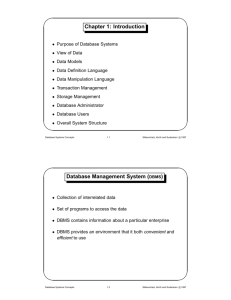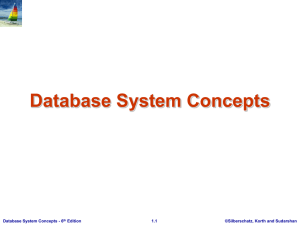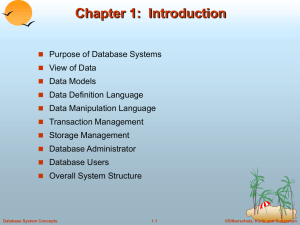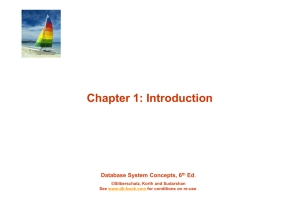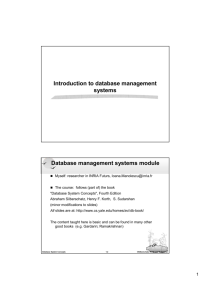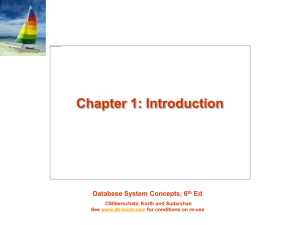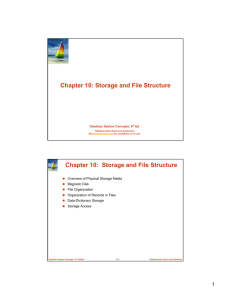R - Computing Systems Laboratory
advertisement
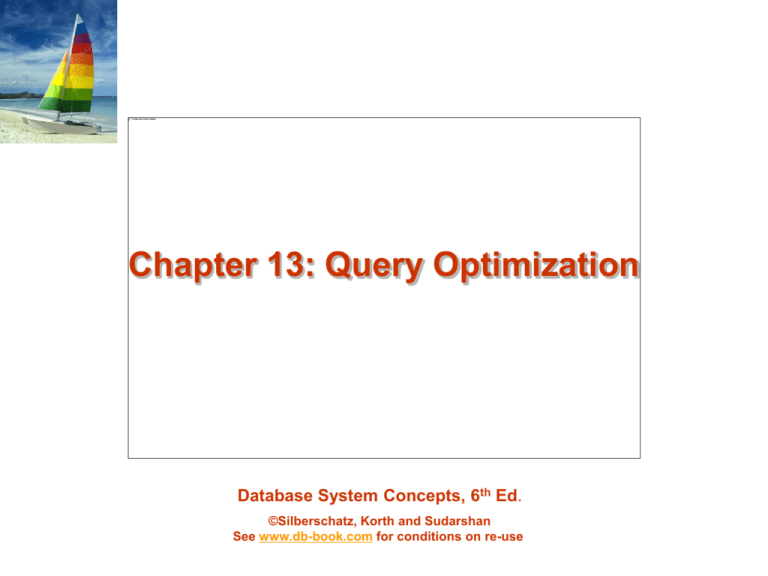
Chapter 13: Query Optimization
Database System Concepts, 6th Ed.
©Silberschatz, Korth and Sudarshan
See www.db-book.com for conditions on re-use
Chapter 13: Query Optimization
Introduction
Transformation of Relational Expressions
Catalog Information for Cost Estimation
Statistical Information for Cost Estimation
Cost-based optimization
Dynamic Programming for Choosing Evaluation
Plans
Materialized views
Database System Concepts - 6th Edition
1.2
©Silberschatz, Korth and Sudarshan
Introduction
Alternative ways of evaluating a given query
Equivalent expressions
Different algorithms for each operation
Database System Concepts - 6th Edition
1.3
©Silberschatz, Korth and Sudarshan
Introduction (Cont.)
An evaluation plan defines exactly what algorithm is used for each
operation, and how the execution of the operations is coordinated.
Find out how to view query execution plans on your favorite database
Database System Concepts - 6th Edition
1.4
©Silberschatz, Korth and Sudarshan
Introduction (Cont.)
Cost difference between evaluation plans for a query can be
enormous
E.g. seconds vs. days in some cases
Steps in cost-based query optimization
1. Generate logically equivalent expressions using equivalence
rules
2. Annotate resultant expressions to get alternative query plans
3. Choose the cheapest plan based on estimated cost
Estimation of plan cost based on:
Statistical information about relations. Examples:
number of tuples, number of distinct values for an attribute
Statistics estimation for intermediate results
to compute cost of complex expressions
Cost formulae for algorithms, computed using statistics
Database System Concepts - 6th Edition
1.5
©Silberschatz, Korth and Sudarshan
Generating Equivalent Expressions
Database System Concepts, 6th Ed.
©Silberschatz, Korth and Sudarshan
See www.db-book.com for conditions on re-use
Transformation of Relational Expressions
Two relational algebra expressions are said to be equivalent if
the two expressions generate the same set of tuples on every
legal database instance
Note: order of tuples is irrelevant
we don’t care if they generate different results on databases
that violate integrity constraints
In SQL, inputs and outputs are multisets of tuples
Two expressions in the multiset version of the relational
algebra are said to be equivalent if the two expressions
generate the same multiset of tuples on every legal
database instance.
An equivalence rule says that expressions of two forms are
equivalent
Can replace expression of first form by second, or vice versa
Database System Concepts - 6th Edition
1.7
©Silberschatz, Korth and Sudarshan
Equivalence Rules
1. Conjunctive selection operations can be deconstructed into a
sequence of individual selections.
s q Ùq ( E ) = s q (s q ( E ))
1
2
1
2
2. Selection operations are commutative.
s q (s q ( E )) = s q (s q ( E ))
1
2
2
1
3. Only the last in a sequence of projection operations is
needed, the others can be omitted.
L1 ( L2 ( ( Ln ( E )) )) L1 ( E )
4. Selections can be combined with Cartesian products and
theta joins.
a.
(E1 X E2) = E1
b.
1(E1
Database System Concepts - 6th Edition
2
E2
E2) = E1
1 2 E2
1.8
©Silberschatz, Korth and Sudarshan
Equivalence Rules (Cont.)
5. Theta-join operations (and natural joins) are commutative.
E1 E2 = E2 E1
6. (a) Natural join operations are associative:
(E1
E2)
E3 = E1
(E2
E3)
(b) Theta joins are associative in the following manner:
(E1
1 E2)
2 3
E3 = E1
1 3
(E2
2
E3)
where 2 involves attributes from only E2 and E3.
Database System Concepts - 6th Edition
1.9
©Silberschatz, Korth and Sudarshan
Pictorial Depiction of Equivalence Rules
Database System Concepts - 6th Edition
1.10
©Silberschatz, Korth and Sudarshan
Equivalence Rules (Cont.)
7. The selection operation distributes over the theta join operation
under the following two conditions:
(a) When all the attributes in 0 involve only the attributes of one
of the expressions (E1) being joined.
0E1
E2) = (0(E1))
E2
(b) When 1 involves only the attributes of E1 and 2 involves
only the attributes of E2.
1 E1
Database System Concepts - 6th Edition
E2) = (1(E1))
1.11
( (E2))
©Silberschatz, Korth and Sudarshan
Equivalence Rules (Cont.)
8. The projection operation distributes over the theta join operation
as follows:
(a) if involves only attributes from L1 L2:
L1 L2 ( E1
(b) Consider a join E1
E2 ) ( L1 ( E1 ))
( L2 ( E2 ))
E2.
Let L1 and L2 be sets of attributes from E1 and E2,
respectively.
Let L3 be attributes of E1 that are involved in join condition ,
but are not in L1 L2, and
let L4 be attributes of E2 that are involved in join condition ,
but are not in L1 L2.
L1 L2 ( E1
Database System Concepts - 6th Edition
E2 ) L1 L2 (( L1 L3 ( E1 ))
1.12
( L2 L4 ( E2 )))
©Silberschatz, Korth and Sudarshan
Equivalence Rules (Cont.)
9. The set operations union and intersection are commutative
E1 E2 = E2 E1
E1 E2 = E2 E1
(set difference is not commutative).
10. Set union and intersection are associative.
(E1 E2) E3 = E1 (E2 E3)
(E1 E2) E3 = E1 (E2 E3)
11. The selection operation distributes over , and –.
(E1
– E2) = (E1) –
(E2)
and similarly for and in place of –
Also:
(E1
– E2) = (E1) – E2
and similarly for in place of –, but not for
12. The projection operation distributes over union
L(E1 E2) = (L(E1)) (L(E2))
Database System Concepts - 6th Edition
1.13
©Silberschatz, Korth and Sudarshan
University DB schema
Database System Concepts - 6th Edition
1.14
©Silberschatz, Korth and Sudarshan
Transformation Example: Pushing Selections
Query: Find the names of all instructors in the Music
department, along with the titles of the courses that they teach
name, title(dept_name= “Music”
(instructor (teaches
course_id, title (course))))
Transformation using rule 7a.
name, title((dept_name= “Music”(instructor))
(teaches
course_id, title (course)))
Performing the selection as early as possible reduces the size
of the relation to be joined.
Database System Concepts - 6th Edition
1.15
©Silberschatz, Korth and Sudarshan
Example with Multiple Transformations
Query:
Find the names of all instructors in the Music department
who have taught a course in 2009, along with the titles of the
courses that they taught
name, title(dept_name= “Music”year = 2009
(instructor (teaches
course_id, title (course))))
Transformation using join associatively (Rule 6a):
name, title(dept_name= “Music”gear = 2009
((instructor teaches)
course_id, title (course)))
Second form provides an opportunity to apply the “perform
selections early” rule, resulting in the subexpression
dept_name = “Music” (instructor)
Database System Concepts - 6th Edition
1.16
year = 2009 (teaches)
©Silberschatz, Korth and Sudarshan
Multiple Transformations (Cont.)
Database System Concepts - 6th Edition
1.17
©Silberschatz, Korth and Sudarshan
Transformation Example: Pushing Projections
Consider: name, title(dept_name= “Music” (instructor)
teaches)
course_id, title (course))))
When we compute
(dept_name = “Music” (instructor
teaches)
we obtain a relation whose schema is:
(ID, name, dept_name, salary, course_id, sec_id, semester,
year)
Push projections using equivalence rules 8a and 8b; eliminate
unneeded attributes from intermediate results to get:
name, title(name, course_id (
dept_name= “Music” (instructor) teaches))
course_id, title (course))))
Performing the projection as early as possible reduces the size
of the relation to be joined.
Database System Concepts - 6th Edition
1.18
©Silberschatz, Korth and Sudarshan
Join Ordering Example
For all relations r1, r2, and r3,
(r1
r 2)
r3 = r1
(r2
r3 )
(Join Associativity)
If r2
r3 is quite large and r1
(r1
r 2)
r2 is small, we choose
r3
so that we compute and store a smaller temporary relation.
Database System Concepts - 6th Edition
1.19
©Silberschatz, Korth and Sudarshan
Join Ordering Example (Cont.)
Consider the expression
name, title(dept_name= “Music” (instructor) teaches)
course_id, title (course))))
Could compute teaches
course_id, title (course) first, and
join result with
dept_name= “Music” (instructor)
but the result of the first join is likely to be a large relation.
Only a small fraction of the university’s instructors are likely to
be from the Music department
it is better to compute
dept_name= “Music” (instructor)
teaches
first.
Database System Concepts - 6th Edition
1.20
©Silberschatz, Korth and Sudarshan
Enumeration of Equivalent Expressions
Query optimizers use equivalence rules to systematically generate
expressions equivalent to the given expression
Can generate all equivalent expressions as follows:
Repeat
apply all applicable equivalence rules on every subexpression of
every equivalent expression found so far
add newly generated expressions to the set of equivalent
expressions
Until no new equivalent expressions are generated above
The above approach is very expensive in space and time
Two approaches
Optimized plan generation based on transformation rules
Special case approach for queries with only selections, projections
and joins
Database System Concepts - 6th Edition
1.21
©Silberschatz, Korth and Sudarshan
Implementing Transformation Based
Optimization
Space requirements reduced by sharing common sub-expressions:
when E1 is generated from E2 by an equivalence rule, usually only the top
level of the two are different, subtrees below are the same and can be
shared using pointers
E.g. when applying join commutativity
E1
Same sub-expression may get generated multiple times
E2
Detect duplicate sub-expressions and share one copy
Time requirements are reduced by not generating all expressions
Dynamic programming
We will study only the special case of dynamic programming for join
order optimization
Database System Concepts - 6th Edition
1.22
©Silberschatz, Korth and Sudarshan
Cost Estimation
Cost of each operator computed as described in Chapter 12
Need statistics of input relations
E.g. number of tuples, sizes of tuples
Inputs can be results of sub-expressions
Need to estimate statistics of expression results
To do so, we require additional statistics
E.g. number of distinct values for an attribute
More on cost estimation later
Database System Concepts - 6th Edition
1.23
©Silberschatz, Korth and Sudarshan
Choice of Evaluation Plans
Must consider the interaction of evaluation techniques when choosing
evaluation plans
choosing the cheapest algorithm for each operation independently
may not yield best overall algorithm. E.g.
merge-join may be costlier than hash-join, but may provide a
sorted output which reduces the cost for an outer level
aggregation.
nested-loop join may provide opportunity for pipelining
Practical query optimizers incorporate elements of the following two
broad approaches:
1. Search all the plans and choose the best plan in a
cost-based fashion.
2. Uses heuristics to choose a plan.
Database System Concepts - 6th Edition
1.24
©Silberschatz, Korth and Sudarshan
Cost-Based Optimization
Consider finding the best join-order for r1
r2
. . . rn.
There are (2(n – 1))!/(n – 1)! different join orders for above expression.
With n = 7, the number is 665280, with n = 10, the number is greater
than 176 billion!
No need to generate all the join orders. Using dynamic programming,
the least-cost join order for any subset of
{r1, r2, . . . rn} is computed only once and stored for future use.
Database System Concepts - 6th Edition
1.25
©Silberschatz, Korth and Sudarshan
Dynamic Programming in Optimization
To find best join tree for a set of n relations:
To find best plan for a set S of n relations, consider all possible
plans of the form: S1 (S – S1) where S1 is any non-empty
subset of S.
Recursively compute costs for joining subsets of S to find the cost
of each plan. Choose the cheapest of the 2n – 2 alternatives.
Base case for recursion: single relation access plan
Apply all selections on Ri using best choice of indices on Ri
When plan for any subset is computed, store it and reuse it when it
is required again, instead of recomputing it
Dynamic programming
Database System Concepts - 6th Edition
1.26
©Silberschatz, Korth and Sudarshan
Join Order Optimization Algorithm
procedure findbestplan(S)
if (bestplan[S].cost )
return bestplan[S]
// else bestplan[S] has not been computed earlier, compute it now
if (S contains only 1 relation)
set bestplan[S].plan and bestplan[S].cost based on the best way
of accessing S /* Using selections on S and indices on S */
else for each non-empty subset S1 of S such that S1 S
P1= findbestplan(S1)
P2= findbestplan(S - S1)
A = best algorithm for joining results of P1 and P2
cost = P1.cost + P2.cost + cost of A
if cost < bestplan[S].cost
bestplan[S].cost = cost
bestplan[S].plan = “execute P1.plan; execute P2.plan;
join results of P1 and P2 using A”
return bestplan[S]
* Some modifications to allow indexed nested loops joins on relations that have
selections (see book)
Database System Concepts - 6th Edition
1.27
©Silberschatz, Korth and Sudarshan
Left Deep Join Trees
In left-deep join trees, the right-hand-side input for each join is
a relation, not the result of an intermediate join.
Database System Concepts - 6th Edition
1.28
©Silberschatz, Korth and Sudarshan
Cost of Optimization
With dynamic programming time complexity of optimization with bushy
trees is O(3n).
With n = 10, this number is 59000 instead of 176 billion!
Space complexity is O(2n)
To find best left-deep join tree for a set of n relations:
Consider n alternatives with one relation as right-hand side input
and the other relations as left-hand side input.
Modify optimization algorithm:
Replace “for each non-empty subset S1 of S such that S1 S”
By: for each relation r in S
let S1 = S – r .
If only left-deep trees are considered, time complexity of finding best join
order is O(n 2n)
Space complexity remains at O(2n)
Cost-based optimization is expensive, but worthwhile for queries on
large datasets (typical queries have small n, generally < 10)
Database System Concepts - 6th Edition
1.29
©Silberschatz, Korth and Sudarshan
Interesting Sort Orders
Consider the expression (r1
r2 )
r3
(with A as common attribute)
An interesting sort order is a particular sort order of tuples that could
be useful for a later operation
Using merge-join to compute r1 r2 may be costlier than hash join
but generates result sorted on A
Which in turn may make merge-join with r3 cheaper, which may
reduce cost of join with r3 and minimizing overall cost
Sort order may also be useful for order by and for grouping
Not sufficient to find the best join order for each subset of the set of n
given relations
must find the best join order for each subset, for each interesting
sort order
Simple extension of earlier dynamic programming algorithms
Usually, number of interesting orders is quite small and doesn’t
affect time/space complexity significantly
Database System Concepts - 6th Edition
1.30
©Silberschatz, Korth and Sudarshan
Cost Based Optimization with Equivalence
Rules
Physical equivalence rules allow logical query plan to be converted
to physical query plan specifying what algorithms are used for each
operation.
Efficient optimizer based on equivalent rules depends on
A space efficient representation of expressions which avoids
making multiple copies of subexpressions
Efficient techniques for detecting duplicate derivations of
expressions
A form of dynamic programming based on memoization, which
stores the best plan for a subexpression the first time it is
optimized, and reuses in on repeated optimization calls on same
subexpression
Cost-based pruning techniques that avoid generating all plans
Pioneered by the Volcano project and implemented in the SQL Server
optimizer
Database System Concepts - 6th Edition
1.31
©Silberschatz, Korth and Sudarshan
Heuristic Optimization
Cost-based optimization is expensive, even with dynamic programming.
Systems may use heuristics to reduce the number of choices that must
be made in a cost-based fashion.
Heuristic optimization transforms the query-tree by using a set of rules
that typically (but not in all cases) improve execution performance:
Perform selection early (reduces the number of tuples)
Perform projection early (reduces the number of attributes)
Perform most restrictive selection and join operations (i.e. with
smallest result size) before other similar operations.
Some systems use only heuristics, others combine heuristics with
partial cost-based optimization.
Database System Concepts - 6th Edition
1.32
©Silberschatz, Korth and Sudarshan
Structure of Query Optimizers
Many optimizers considers only left-deep join orders.
Plus heuristics to push selections and projections down the query
tree
Reduces optimization complexity and generates plans amenable to
pipelined evaluation.
Heuristic optimization used in some versions of Oracle:
Repeatedly pick “best” relation to join next
Starting from each of n starting points. Pick best among these
Intricacies of SQL complicate query optimization
E.g. nested subqueries
Database System Concepts - 6th Edition
1.33
©Silberschatz, Korth and Sudarshan
Structure of Query Optimizers (Cont.)
Some query optimizers integrate heuristic selection and the generation of
alternative access plans.
Frequently used approach
heuristic rewriting of nested block structure and aggregation
followed by cost-based join-order optimization for each block
Some optimizers (e.g. SQL Server) apply transformations to entire query
and do not depend on block structure
Optimization cost budget to stop optimization early (if cost of plan is
less than cost of optimization)
Plan caching to reuse previously computed plan if query is resubmitted
Even with different constants in query
Even with the use of heuristics, cost-based query optimization imposes a
substantial overhead.
But is worth it for expensive queries
Optimizers often use simple heuristics for very cheap queries, and
perform exhaustive enumeration for more expensive queries
Database System Concepts - 6th Edition
1.34
©Silberschatz, Korth and Sudarshan
Statistics for Cost Estimation
Database System Concepts, 6th Ed.
©Silberschatz, Korth and Sudarshan
See www.db-book.com for conditions on re-use
Statistical Information for Cost Estimation
nr: number of tuples in a relation r.
br: number of blocks containing tuples of r.
lr: size of a tuple of r.
fr: blocking factor of r — i.e., the number of tuples of r that fit into one block.
V(A, r): number of distinct values that appear in r for attribute A; same as
the size of A(r).
If tuples of r are stored together physically in a file, then:
nr ùú
br =
f r úú
é
ê
ê
ê
Database System Concepts - 6th Edition
1.36
©Silberschatz, Korth and Sudarshan
Histograms
Histogram on attribute age of relation person
frequency
50
40
30
20
10
1–5
6–10
11–15 16–20 21–25
value
Equi-width histograms
Equi-depth histograms
Database System Concepts - 6th Edition
1.37
©Silberschatz, Korth and Sudarshan
Selection Size Estimation
A=v(r)
nr / V(A,r) : number of records that will satisfy the selection
Equality condition on a key attribute: size estimate = 1
AV(r) (case of A V(r) is symmetric)
Let c denote the estimated number of tuples satisfying the condition.
If min(A,r) and max(A,r) are available in catalog
c = 0 if v < min(A,r)
c=
nr .
v - min( A, r )
max( A, r ) - min( A, r )
If histograms available, can refine above estimate
In absence of statistical information c is assumed to be nr / 2.
Database System Concepts - 6th Edition
1.38
©Silberschatz, Korth and Sudarshan
Size Estimation of Complex Selections
The selectivity of a condition
relation r satisfies i .
i is the probability that a tuple in the
If si is the number of satisfying tuples in r, the selectivity of i is
given by si /nr.
Conjunction:
1 2. . . n (r). Assuming indepdence, estimate of
tuples in the result is:
s1 * s2 * . . . * sn
nr *
nrn
Disjunction:1 2 . . . n (r). Estimated number of tuples:
æ
s
s
s ö
nr * çç1 - (1 - 1 ) * (1 - 2 ) * ... * (1 - n ) ÷÷
nr
nr
nr ø
è
Negation: (r). Estimated number of tuples:
nr – size((r))
Database System Concepts - 6th Edition
1.39
©Silberschatz, Korth and Sudarshan
Join Operation: Running Example
Running example:
student
takes
Catalog information for join examples:
nstudent = 5,000.
fstudent = 50, which implies that
bstudent =5000/50 = 100.
ntakes = 10000.
ftakes = 25, which implies that
btakes = 10000/25 = 400.
V(ID, takes) = 2500, which implies that on average, each student
who has taken a course has taken 4 courses.
Attribute ID in takes is a foreign key referencing student.
V(ID, student) = 5000 (primary key!)
Database System Concepts - 6th Edition
1.40
©Silberschatz, Korth and Sudarshan
Estimation of the Size of Joins
The Cartesian product r x s contains nr .ns tuples; each tuple occupies
sr + ss bytes.
If R S = , then r
s is the same as r x s.
If R S is a key for R, then a tuple of s will join with at most one tuple
from r
therefore, the number of tuples in r
number of tuples in s.
s is no greater than the
If R S in S is a foreign key in S referencing R, then the number of
tuples in r
s is exactly the same as the number of tuples in s.
The case for R S being a foreign key referencing S is
symmetric.
In the example query student
takes, ID in takes is a foreign key
referencing student
hence, the result has exactly ntakes tuples, which is 10000
Database System Concepts - 6th Edition
1.41
©Silberschatz, Korth and Sudarshan
Estimation of the Size of Joins (Cont.)
If R S = {A} is not a key for R or S.
If we assume that every tuple t in R produces tuples in R
number of tuples in R S is estimated to be:
S, the
nr * ns
V ( A, s )
If the reverse is true, the estimate obtained will be:
nr * ns
V ( A, r )
The lower of these two estimates is probably the more accurate one.
Can improve on above if histograms are available
Use formula similar to above, for each cell of histograms on the
two relations
Database System Concepts - 6th Edition
1.42
©Silberschatz, Korth and Sudarshan
Estimation of the Size of Joins (Cont.)
Compute the size estimates for depositor
customer without using
information about foreign keys:
V(ID, takes) = 2500, and
V(ID, student) = 5000
The two estimates are 5000 * 10000/2500 = 20,000 and 5000 *
10000/5000 = 10000
We choose the lower estimate, which in this case, is the same as
our earlier computation using foreign keys.
Database System Concepts - 6th Edition
1.43
©Silberschatz, Korth and Sudarshan
Additional Optimization Techniques
Nested Subqueries
Materialized Views
Database System Concepts, 6th Ed.
©Silberschatz, Korth and Sudarshan
See www.db-book.com for conditions on re-use
Optimizing Nested Subqueries**
Nested query example:
select name
from instructor
where exists (select *
from teaches
where instructor.ID = teaches.ID and teaches.year = 2007)
SQL conceptually treats nested subqueries in the where clause as
functions that take parameters and return a single value or set of values
Parameters are variables from outer level query that are used in the
nested subquery; such variables are called correlation variables
Conceptually, nested subquery is executed once for each tuple in the
cross-product generated by the outer level from clause
Such evaluation is called correlated evaluation
Note: other conditions in where clause may be used to compute a join
(instead of a cross-product) before executing the nested subquery
Database System Concepts - 6th Edition
1.45
©Silberschatz, Korth and Sudarshan
Optimizing Nested Subqueries (Cont.)
Correlated evaluation may be quite inefficient since
a large number of calls may be made to the nested query
there may be unnecessary random I/O as a result
SQL optimizers attempt to transform nested subqueries to joins where
possible, enabling use of efficient join techniques
E.g.: earlier nested query can be rewritten as
select name
from instructor, teaches
where instructor.ID = teaches.ID and teaches.year = 2007
Note: the two queries generate different numbers of duplicates (why?)
teaches can have duplicate IDs
Can be modified to handle duplicates correctly as we will see
In general, it is not possible/straightforward to move the entire nested
subquery from clause into the outer level query from clause
A temporary relation is created instead, and used in body of outer
level query
Database System Concepts - 6th Edition
1.46
©Silberschatz, Korth and Sudarshan
Optimizing Nested Subqueries (Cont.)
In general, SQL queries of the form below can be rewritten as shown
Rewrite: select …
from L1
where P1 and exists (select *
from L2
where P2)
To:
create table t1 as
select distinct V
from L2
where P21
select …
from L1, t1
where P1 and P22
P21 contains predicates in P2 that do not involve any correlation
variables
P22 reintroduces predicates involving correlation variables, with
relations renamed appropriately
V contains all attributes used in predicates with correlation
variables
Database System Concepts - 6th Edition
1.47
©Silberschatz, Korth and Sudarshan
Optimizing Nested Subqueries (Cont.)
In our example, the original nested query would be transformed to
create table t1 as
select distinct ID
from teaches
where year = 2007
select name
from instructor, t1
where t1.ID = instructor.ID
The process of replacing a nested query by a query with a join (possibly
with a temporary relation) is called decorrelation.
Decorrelation is more complicated when
the nested subquery uses aggregation, or
when the result of the nested subquery is used to test for equality, or
when the condition linking the nested subquery to the other
query is not exists,
and so on.
Database System Concepts - 6th Edition
1.48
©Silberschatz, Korth and Sudarshan
